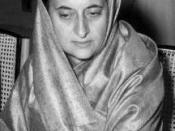India and China are two countries that have experienced a rapid growth in population over the past few decades. Each of the two countries has a population in excess of one billion people and combined they represent over one-third of the world's population. As the population of these two countries has grown dramatically, so have their economies. In fact, their economies have developed so quickly that many economists have labeled China and India as the world's next major powers. Although the economies of these two emerging superpowers continue to grow they each face unique challenges in maintaining economic stability. (Chen, Kuan-I, 3)Achieving these levels of economic growth and gaining status as emerging world powers was not easy for India or China. "The present governments in both countries inherited economies torn by partition in the case of India and civil strife in China and exploited by foreign colonial interests." (Chen, Kuan-I, 3)India was faced with the difficult task of rebuilding their economy after winning their independence from the British.
Freedom from colonial rule presented the newly independent Indian nation with many opportunities as well as challenges. The main challenge India faced was creating a viable economy that could maintain stability without foreign assistance.
China sought to gain economic stability after civil war had plagued the nation. The Chinese Communist Party inherited this complicated task when they defeated the Nationalist Party and gained control over Mainland China in 1950. Before the Communist Party could implement any economic reforms they first had to unify a country that had been in turmoil for years.
The governments of India and China were each faced with the complicated task of rebuilding their economies during the late 1940's and early 1950's. While each country had similar goals and expectations for economic development they were led by contrasting...


